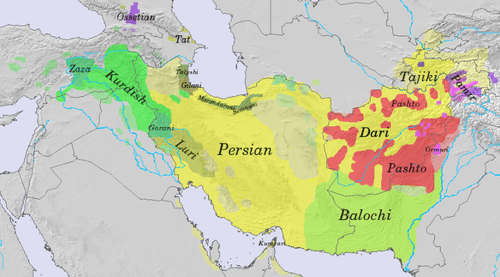Western Iranian languages
The Western Iranian languages are a branch of the Iranian languages, attested from the time of Old Persian (6th century BC) and Median.
| Western Iranian | |
|---|---|
| Geographic distribution | Southwest Asia, Central Asia, Caucasus, and western South Asia |
| Linguistic classification | Indo-European
|
| Subdivisions |
|
| Glottolog | west2794[1] |
Languages

Map of modern Iranian languages. The Western Iranian languages are shaded yellow/green.
The traditional Northwestern branch is a convention for non-Southwestern languages, rather than a genetic group. The languages are as follows:[2][3]
- Old Iranian
- Southwest: Old Persian†
- Northwest: Median†
- Middle Iranian
- Southwest: Middle Persian†
- Northwest: Parthian†
- Neo-Iranian
- Northwestern I
- Kurdish languages
- Zaza–Gorani languages
- Zaza language (dialects: Kirmanjki, Dimli)
- Gorani language (dialects: Hawrami, Bajelan)
- Shabaki language
- Northwestern II
- Balochi: Balochi, ?Koroshi
- Khuri (Kavir)
- Tatic
- Talysh
- Tati/Azari: Old Azeri†, Harzandi, Karingani, Kho'ini, Khalkhal, Upper Taromi, Rudbari, Southern Tati, Eshtehardi, dialects N/NE of Qazvin
- ? (Talysh? Tati?): Gozarkhani, Kajali, Koresh-e Rostam, Maraghei, Razajerdi, Shahrudi
- Tafresh (transitional): Ashtiani (Amora’i, Kahaki), Vafsi, Alviri-Vidari (Alviri, Vidari), ?Judeo-Hamadani
- Central / Central Plateau (Kermanic)[4]
- Northwestern: Khunsari, Mahallati, Vanishani, Judeo-Golpaygani
- Southwestern: Gazi, Sedehi, Ardestani, Nohuji, Sajzi, Jarquya’i, Rudashti, Kafrudi, Kafruni, Judeo-Esfahani
- Northeastern: Arani, Bidgoli, Delijani, Nashalji, Abuzaydabadi, Qohrudi, Badrudi, Kamu’i, Jowshaqani, Meyma’i, Abyana’i, Soi, Badi, Natanzi, Kasha’i, Tari, Tarqi, Judeo-Kashani
- Southeastern: Zoroastrian Dari, Nayini, Zefra’i, Varzenei, Tudeshki, Keyjani, Abchuya’i
- Northwestern III
- Southwestern (cf. dialects of Fars)
- Persian (dialects: Iranian Persian, Dari Persian (Madaglashti), Tajik Persian, Hazaragi Persian, Aimaq, Sistani, Pahlavani Persian†, Dzhidi Persian (Judeo-Persian), Judeo-Bukharic, Muslim/Christian Tat, Judeo-Tat, Laki
- Persid
- Achomi–Gulf
An Iranian Khalaj language has been claimed but does not exist; the Khalaj speak a Turkic language.
The dialects of Central Iran are a geographic rather than genetic grouping. They are spoken mostly in Markazi and Isfahan provinces. Many of them are giving way to Persian in the younger generations.[4]
gollark: Yep!
gollark: Anyway: firstly, I cannot actually solder, and secondly it uses USB-C.
gollark: The touchscreen decided to start being annoying, so it's *effectively* dead.
gollark: Hmm. I suppose if I can't make anything else work I can probably get an adapter for a mouse.
gollark: I might have, but I think that still has a prompt on the device, and I'd need to enter the decryption key on screen, as far as I know.
See also
References
- Hammarström, Harald; Forkel, Robert; Haspelmath, Martin, eds. (2017). "Western Iranian". Glottolog 3.0. Jena, Germany: Max Planck Institute for the Science of Human History.
- Gernot Windfuhr, 2009, "Dialectology and Topics", The Iranian Languages, Routledge
- Languages preceded by question marks, and many of the varieties of Persian, are from other sources. The dialects of the Central Plateau are from the source provided there.
- Central dialects, Gernot Windfuhr, Encyclopedia Iranica
- Glottolog changed the designation of this language family from "Semnanic" (https://glottolog.org/files/glottolog-2.7/semn1240.htmt) to "Komisenian"(https://glottolog.org/resource/languoid/id/komi1276). This designation has been also adopted by Wiktionary (https://en.wiktionary.org/wiki/Category:Komisenian_languages)
- Borjian, Habib, “Kerman Languages”, Encyclopaedia Iranica. Volume 16, Issue 3, 2017, pp. 301-315.
Bibliography
- Compendium Linguarum Iranicarum, ed. Rüdiger Schmitt. Wiesbaden: L. Reichert Verlag, 1989; p. 99.
External links
- "Contact and the diversity of noun-noun subordination strategies among Western Iranic languages" (PDF). Nicholas Kontovas Indiana University Bloomington, Bloomington, Indiana, USA.
This article is issued from Wikipedia. The text is licensed under Creative Commons - Attribution - Sharealike. Additional terms may apply for the media files.